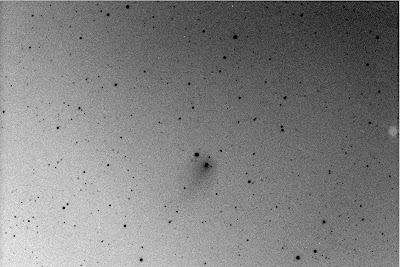After a few hours sleep last night I went up to the observatory to open up. The ground was covered in ice and frost and the clamshell was covered in a coating of ice. I pressed the open button and nothing happened - the clams were frozen. Pushed up on one side to break the seal and it opened. That was in fact the highlight of the observing session. By the time I walked back down to the house and sat down at my desk had sat down the sky clouded over and for the next couple of hours only caught a few glimpses of C/2012 S1 ISON.
So back to yesterday.
After Wednesday I thought it would be a long time before such excitement would come around again. I was wrong!
I had opened up the observatory a little late so only spent a short time on C/2013 R1 Love joy, (note to self must get round to processing those images). Then onto C/2012 S1 ISON. After moving the telescope slightly I took a one minute exposure to check I had as much as possible on the frame.
I looked at it and thought where is the second tail. Looked again and saw that there were multiple tails. Quickly changed the setting to a 3 minute exposure and binned 3- (basically that means that a 3 x 3 square of pixels is treated as a single pixel - bigger pixels mean more light captured quickly). Started to take the image - 3 minutes gave me the chance to make a quick cup of coffee :) - the image downloaded and I thought Wow! What has happened to it?
I felt as though I was looking at an old woodcut or engraving. Just look at it and imagine if it filled the sky as some great comets have in the past.
I sent this image along with a negative to CIOC_ISON for Padma to look at and also to Comet Watch for Neil.
Negatives are very useful as they are easier on the eye for seeing the detail. To say that when people saw this caused some interest, would be an understatement.
From downloading the image from the camera to it being up for people to view was achieved in about ten minutes. This enabled people to react to the change, either discuss what was happening or assisting in preparing to follow up.
To achieve this speed I do have to keep the processing simple. Flat and Dark frames have been applied, the background normalised, the image slightly stretched to bring out detail, in this case rotated 180 degrees so that north is up and then first saved as a positive then a negative and finally uploaded to the sites.
If you are a serious comet observer then you may wish to join
CIOC_ISON and you are a Facebook user then click on the link.
While doing this more images were needed and I set of a cycle of LRGB image taking. This involves the camera taking multiple images, rotating through clear, red, green and blue filters. Twenty seconds per image. That was when the cloud came in and only nineteen more images were taken.
It was time for a quick cup of coffee and then shutting the observatory.
Between answering and asking questions I processed four of the last set of images to produce a colour image. Because these were short exposures the coma (head) of the comet looks smaller and there is less detain in the tail.
You can though still see the multiple tails an yes the comet is green. During the rest of the day I continued to keep uptodate with the comet, taking part in a number of discussions and a number of other activities.
These activities including sending images to the
Comet Section of the
British Astronomical Association . Later in the day there was a report and ebulletin issued.
I also produced a montage based on the last seven days activity up to yesterday.
Although simple to put together it went down very well with all the people who saw it.
I was asked during the day for permission to display a number of the images on various websites. I may cover this in a later blog.
Finally I did a prerecroded interview with Paul Harper of
Under British Skies
and this will be broadcasted on Sunday. Although I will be talking about the comet the interview I was first asked about what is Searchlight Observatory Network. I only hope that I get it right. :) For more on the comet there is at least one other person covering it and that is
+Padma Yanamandra-Fisher and I expect that she will be the highlight of the show. Padma is responsible for the CIOC_ISON Group on Facebook.
The CIOC_ISON Group is an a forum to provide support for professional and amateur comet observers to: share, discuss and collaborate on observations of comet ISON, as part of NASA's Comet ISON Observing Campaign (CIOC).
Well that is the description! but it is a lot more than that.
Detailed information about the CIOC is located at:
http://www.isoncampaign.org/
I finally got to bed twenty four hours after last in it.































































